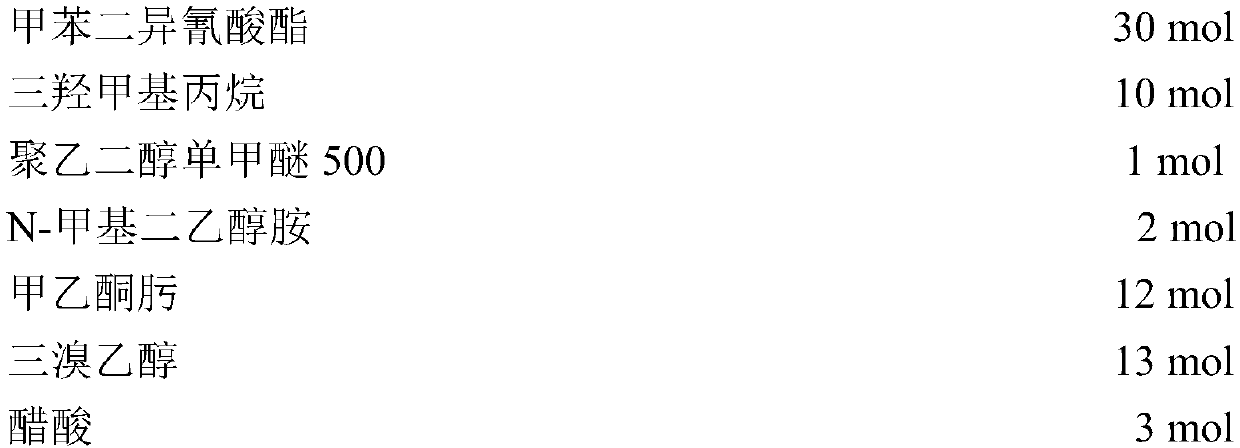Laundering-resisting flame-retarding synergist for textiles as well as preparation method and application thereof
A polyurethane flame retardant and reaction technology, which is applied in the direction of textiles and papermaking, flame retardant fibers, fiber types, etc., can solve the problems affecting the repeated use of textiles, the water repellency of textiles, and the water repellency of fabrics, and achieve excellent performance. Effect of flame retardancy and water repellency, improvement of repeated use, long-lasting flame retardancy
- Summary
- Abstract
- Description
- Claims
- Application Information
AI Technical Summary
Problems solved by technology
Method used
Image
Examples
Embodiment 1
[0051] Polyurethane emulsion formulation:
[0052]
[0053]Textile washing resistance flame retardant synergist formula:
[0054]
[0055] 1. Preparation
[0056] (1) Under the protection of inert gas nitrogen, react 30mol toluene diisocyanate with 10mol trimethylolpropane at 60°C for 1.5h to prepare -NCO group-terminated prepolymer I, and then add 2mol of N-methyl diisocyanate Ethanolamine and 1 mol of polyethylene glycol monomethyl ether 500 were reacted at 60°C for 2 hours to prepare prepolymer II (reacted to the set -NCO group content);
[0057] (2) The prepolymer II and 13mol of tribromoethanol were subjected to a capping reaction at 60°C for 2 hours to obtain the prepolymer III (reacted to the set -NCO group content), and then the prepolymer III was mixed with 12mol of methyl ethyl ketone The oxime was subjected to capping reaction at 60°C for 4h (reaction until the -NCO group content was set to zero), cooled to below 40°C and added 3mol acetic acid for neutraliz...
Embodiment 2
[0066] Polyurethane emulsion formulation:
[0067]
[0068] Textile washing resistance flame retardant synergist formula
[0069]
[0070] 1. Preparation
[0071] (1) Under the protection of inert gas nitrogen, react 30mol isophorone diisocyanate with 10mol trimethylolpropane at 60°C for 1.5h to prepare -NCO group-terminated prepolymer I, and then add 2mol of N- Methyldiethanolamine and 1mol of polyethylene glycol monomethyl ether 500 were reacted at 60°C for 2 hours to prepare prepolymer II (reacted to the set -NCO group content);
[0072] (2) The prepolymer II and 13mol of tribromoethanol were subjected to a capping reaction at 60°C for 2 hours to obtain the prepolymer III (reacted to the set -NCO group content), and then the prepolymer III was mixed with 12mol of methyl ethyl ketone The oxime was subjected to capping reaction at 60°C for 4h (reaction until the -NCO group content was set to zero), cooled to below 40°C and added 3mol acetic acid for neutralization rea...
Embodiment 3
[0081] Polyurethane emulsion formulation:
[0082]
[0083] Textile washing resistance flame retardant synergist formula:
[0084]
[0085] 1. Preparation
[0086] (1) Under the protection of inert gas nitrogen, react 30mol toluene diisocyanate with 10mol trimethylolpropane at 60°C for 1.5h to prepare -NCO group-terminated prepolymer I, and then add 2mol of N-methyl diisocyanate Ethanolamine and 1 mol of polyethylene glycol monomethyl ether 500 were reacted at 60°C for 2 hours to prepare prepolymer II (reacted to the set -NCO group content);
[0087] (2) Prepolymer II and 13mol of trichloroethanol were capped at 60°C for 2 hours to obtain prepolymer III (reacted to the set -NCO group content), and then prepolymer III was mixed with 12mol of methyl ethyl ketone The oxime was subjected to capping reaction at 60°C for 4h (reaction until the -NCO group content was set to zero), cooled to below 40°C and added 3mol acetic acid for neutralization reaction for 0.5h, and finall...
PUM
 Login to View More
Login to View More Abstract
Description
Claims
Application Information
 Login to View More
Login to View More - R&D
- Intellectual Property
- Life Sciences
- Materials
- Tech Scout
- Unparalleled Data Quality
- Higher Quality Content
- 60% Fewer Hallucinations
Browse by: Latest US Patents, China's latest patents, Technical Efficacy Thesaurus, Application Domain, Technology Topic, Popular Technical Reports.
© 2025 PatSnap. All rights reserved.Legal|Privacy policy|Modern Slavery Act Transparency Statement|Sitemap|About US| Contact US: help@patsnap.com



